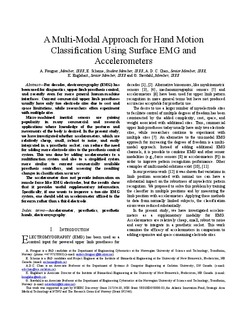A Multi-Modal Approach for Hand Motion Classification Using Surface EMG and Accelerometers
Journal article, Peer reviewed
Accepted version
Permanent lenke
http://hdl.handle.net/11250/2392221Utgivelsesdato
2011Metadata
Vis full innførselSamlinger
Originalversjon
IEEE Engineering in Medicine and Biology Society. Conference Proceedings 2011, 33:4247-4250 10.1109/IEMBS.2011.6091054Sammendrag
For decades, electromyography (EMG) has been used for diagnostics, upper-limb prosthesis control, and recently even for more general human-machine interfaces. Current commercial upper limb prostheses usually have only two electrode sites due to cost and space limitations, while researchers often experiment with multiple sites. Micro-machined inertial sensors are gaining popularity in many commercial and research applications where knowledge of the postures and movements of the body is desired. In the present study, we have investigated whether accelerometers, which are relatively cheap, small, robust to noise, and easily integrated in a prosthetic socket; can reduce the need for adding more electrode sites to the prosthesis control system. This was done by adding accelerometers to a multifunction system and also to a simplified system more similar to current commercially available prosthesis controllers, and assessing the resulting changes in classification accuracy. The accelerometer does not provide information on muscle force like EMG electrodes, but the results show that it provides useful supplementary information. Specifically, if one wants to improve a two-site EMG system, one should add an accelerometer affixed to the forearm rather than a third electrode.
